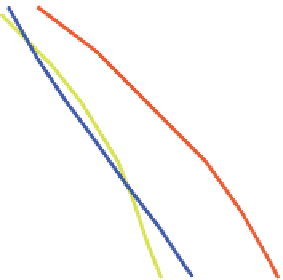Geoscience Reference
In-Depth Information
Acoustic Impedance
Class III
Limestone
Class II
Class I
Sandstone
mudstone
Fig. 5.10
instead have to calculate it from the source-receiver offset. A very rough approximation
would be to assume that the ray-path from surface to reflector is straight, but this
invariably underestimates the angle of incidence because of refraction effects caused
by velocity increase with depth. Ray-tracing through the overburden velocity structure
will give an accurate estimate, but an approximate formula for the incidence angle at
offset
X
and zero-offset travel time
T
0
is
V
int
V
rms
(
V
rms
T
0
)
2
X
2
sin
2
θ
=
,
X
2
+
where
V
int
is the interval velocity at travel time
T
0
, and
V
rms
is the rms velocity from
the surface to
T
0
(i.e. approximately, the stacking velocity).
Measuring AVO gradient from real gathers is not entirely straightforward. Residual
moveout can distort the measurement.
Figure 5.11
shows traces from a CDP gather,
where correction for NMO has not been accurate, and as a result the reflectors are not
flat. The true AVO gradient would be found by measuring the amplitude along the peak
or trough of a reflection. If the amplitudes are taken instead at a constant time sample,
as may be the case with software designed for bulk processing of data, then the gradient
will be too high. One way round this is to use trace-to-trace correlation to follow the
loop across the gather (in effect, to autotrack it). This will not work in the case of a
class IIp response, because of the polarity reversal. A further problem in estimating
AVO gradient is that there are bound to be scaling issues between near and far offsets.
A spherical divergence correction will have been applied during processing of the data
to correct for the systematic decrease of amplitude with offset due to the increase in
length of the travel path. If this correction is inaccurate, then there will be a tendency
for all reflectors to show the same change in amplitude with offset, e.g. a systematic
decrease. There are other possible causes of such systematic effects: the seismic source
may emit a stronger signal in the vertical than in an oblique direction, and receiver










